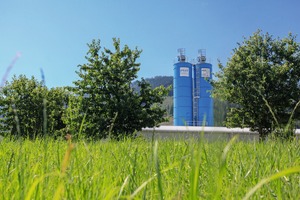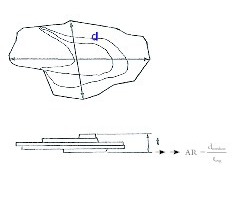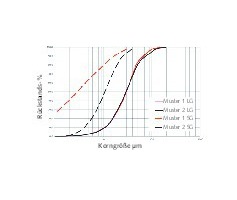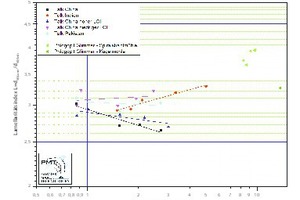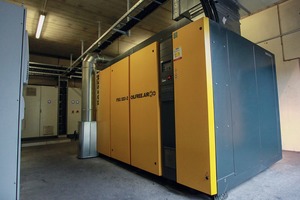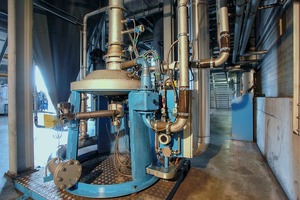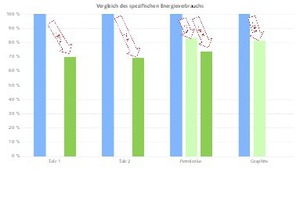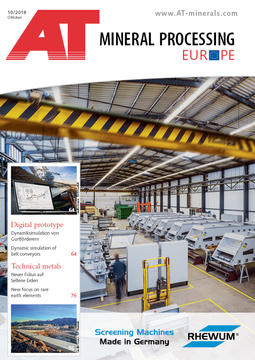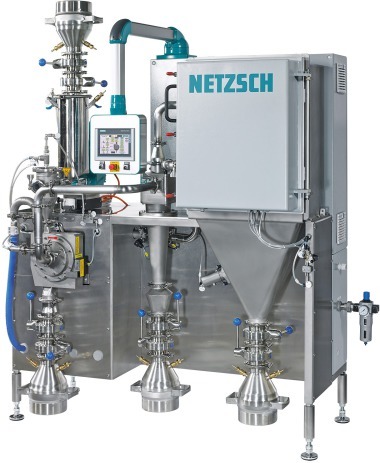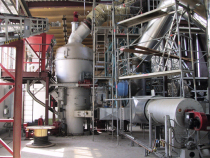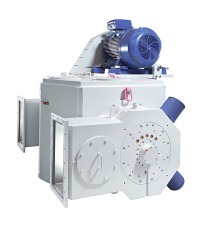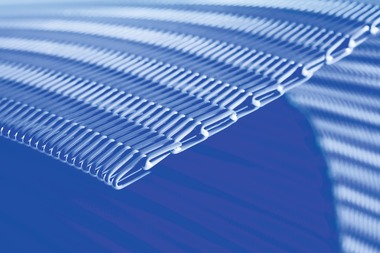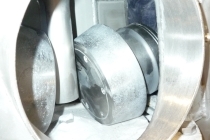The new Enhanced Energy Utilization (EEU) system for the PMT jet mill
Summary: Requirements for fillers are steadily changing in the direction of functional additives. An essential precondition for these functional properties is extreme fineness, but also particle shape. To improve efficiency in the micronization of these highly lamellar fillers, the efficiency of the PMT spiral jet mill has been markedly improved with the development of the Enhanced Energy Utilization (EEU) system.
1 Introduction
The users of fillers, primarily from the plastics industry, are increasing their requirements for these materials. The material profile is changing from pure volume filler to functional additives and fillers. These functional properties are associated not only with fineness but with particle shape.
Modern spiral jet mills are the state of the art in the micronization of highly lamellar fillers. With their specific type of comminution based on shear forces, the particle shape significant for the downstream applications – whether in flake or needle form – can be preserved or even improved.
But with this grinding process, naturally the pressure of economic efficiency is growing, too. To enhance this, the efficacy of the proven PMT spiral jet mill could be improved substantially with the development of the EEU (Enhanced Energy Utilization) system. On the one hand, this system consists of a compressor that supplies compressed air with much higher outlet temperature and, on the other hand, of selective water injection.
2 Basic principles
As well as with steam, jet mills are usually operated with compressed air. When the energy is utilized in the grinding jets, not only the pressure energy, but to a large extent the thermal energy can be used. This thermal energy is generated during compression in any case and can be used to a large extent in single-stage systems; in multistage compressor systems, part of it must be eliminated in the intermediate cooler. Minimizing this part is the objective to improve overall energy efficiency.
Especially in the field of highly lamellar and needle-shaped industrial minerals, today almost exclusively spiral jet mills are used, in which comminution is achieved primarily by means of shear forces, which can have a delaminating effect.
3 Particle size determination and aspect ratio
In grinding and classifying systems, the basis of many product definitions is the particle size distribution of the ground products. The various methods for determination of these values deliver very different values. The measurement methods most common in the fine and very fine range – laser granulometry and sedimentation analysis – differ more and more widely, the more the particle shape deviates from the ideal sphere.
The aspect ratio is a measure for the lamellarity of the product and is the ratio of the largest dimension to the smallest, in the case of lamellar products, for example, the ratio of the diameter of a flake to its thickness (Fig. 1), in the case of needle-shaped products, the ratio of the length to the diameter of a needle. There are a large number of different methods for evaluation of the aspect ratio. Common to all is a more or less high degree of subjectivity of the evaluator.
One possibility is to utilize the above-mentioned differences in the measurement of the particle distribution for qualitative assessment of the aspect ratios. For this the lamellarity index can be used as the ratio of the d50 values determined once by means of laser granulometry and once by means of sedimentation analysis.
L = d50,Laser
d50,Sedigraph
Fig. 2 shows a comparison of these two measurement methods on two industrial mineral samples with different lamellarity. It can be seen that products with higher lamellarity (Sample 1 – red curves) show a much larger difference between the two methods (LG laser granulometry – SG sedigraph) than products with lower lamellarity (Sample 2 – black curves). In this example, Sample 1 shows a lamellarity index of around 10, Sample 2, on the other hand, only just above 3.
A large number of comparative grindings and tests has shown that a qualitative estimation of the aspect ratio with this method is certainly suitable for this purpose (Fig. 3). It has also been shown that in the selection of suitable grinding methods the lamellarity or the aspect ratio brings with it relatively low variations with particle size.
4 Using functional fillers
Especially with the use of such highly lamellar industrial minerals as functional fillers, for example, in plastics applications or in the production of paints and lacquers, it has been shown that especially mechanical properties like stiffness, impact strength, scratch resistance, etc. could be improved considerably. This especially because the aspect ratio, even in the finest particle size range, can be preserved or even increased slightly with the use of appropriate grinding systems, like the spiral jet mill.
5 EEU system – Enhanced Energy Utilization
Another key aspect with regard to ultrafine functional fillers is, however, also the energy-efficient and therefore economic production of these products. This implies that even products in the finest particle size range can be produced in industrial volumes or that the capacity per machine unit is increased. Here the efficient production of compressed air is important, but far more important for the grinding performance is high efficiency in the utilization of the thermal and pressure energy in the compressed air into grinding power.
Single-stage compressors are limited in their maximum pressure that is why they are only used in few grinding systems. The lower pressure must be compensated by larger compressed air volumes, to achieve the same capacity as in mills with high-pressure compressors. Accordingly, the size of the mill per tonne of ground product increases. That part of the energy of the compressed air which, however, has the higher influence on the grinding performance is the thermal component.
Working together with the renowned compressor manufacturer KAESER (//www.kaeser.at" target="_blank" >www.kaeser.at:www.kaeser.at), PMT Jetmill has developed a compressor (Fig. 4) which, thanks to reduced intermediate cooling, ensures a much higher outlet temperature of the compressed air up to 240 °C with constant energy input. This step alone already leads, depending on the material being ground, to a reduction in the specific energy requirement per tonne of finished product of more than 15 % compared with standard compressors and jet mills.
With the specific water injection direct in the grinding chamber (Fig. 5), the residual thermal energy part can be used further. On the one hand, the grinding effect is improved by the immediate expansion on evaporation of the water and, on the other hand, the classifying efficiency of the installed high-dynamic classifier is enhanced as a result of the general cooling of the system.
Basis of the separation process in classifiers between fine and coarse material is the equilibrium of forces between the repellent centrifugal force of the rotating classifier cage and the entraining radial force of the air stream. The basic setting in operation is the speed and therefore peripheral speed determining the centrifugal force. If a laminar particle flow is assumed, which is permissible for particle sizes < 100 µm, the cut-point, that is the particle size at which centrifugal and radial force are in equilibrium, can be found with the help of Stokes‘ equation:
dT = 18 · ηdyn · νr · r
(rs - rl) · v 2u
Besides the described setting for the peripheral velocity, there are other parameters that cannot be changed in the normal case. These are essentially the material parameters like the density of the materials and the air as well as their dynamic viscosity. The radial intake speed vr is influenced by the state variables of the air.
The cooling effects, on the one hand, an increase in the density of the air and accordingly a reduction in the air volume flow or the radial intake velocity in the classifier rotor and, on the other hand, a reduction in the dynamic viscosity of the air. These two factors lead to a considerable reduction in the peripheral velocity of the classifier rotor at the same product fineness. Generally, in the PMT spiral jet mill in a comparison between EEU system and conventional operation, a reduction in the classifier speed of around 10 – 15 % can be realized. Accordingly, with a constant good oversize limit, a steeper particle distribution with lower fines content can be achieved.
The dosing of the water is controlled based on the relative moisture to avoid condensation of the water in the system. Up to a final exit of the air from the system, an undersaturated operation is guaranteed. With the use of the entire Enhanced Energy Utilization system, consisting of the high temperature of the compressed air and the water injection, an up to 30-% reduction in the specific energy requirement per tonne finished product can be achieved (Fig. 6).
6. Conclusion
The requirements for fillers are changing increasingly in the direction of functional additives. Essential for these functional properties is besides the extreme fineness also the particle shape. For example, the improvement of the mechanical properties in plastics is linked particularly to fillers with a high aspect ratio, i.e. the strengthening effect increases with aspect ratio.
Spiral jet mills comminute primarily based on shear forces, which leads to an improved delamination of the products. With the installed high-dynamic classifier in the PMT jet mill, the requirement for ultrafine products with a precisely limited oversize can be fulfilled.
An important aspect in the economic production of correspondingly high-fineness, delaminated products is a maximized utilization of the input energy. In jet mills, this energy is often made available in the form of compressed air. In the utilization in grinding efficiency, besides the pressure energy, especially the thermal energy generated during compression is essential. Therefore the temperature of the compressed air should be as high as possible up until it is implemented in the grinding jets. That means that especially in the case of multistage compressors, the least possible amount of energy should be dissipated in the area of intermediate cooling.
With selective water injection, the residual heat can be converted by immediate evaporation into grinding efficiency. With this evaporation, the entire system is cooled, which leads to an increase in efficiency in the classification based on the reduction of the required peripheral speed. With these measures, in the PMT spiral jet mill thanks to its equipment with the described EEU system, the specific energy consumption can be reduced by up to 30 % or the throughput rate can be increased by up to 30 % depending on the material with constant energy input and the same machine size.

